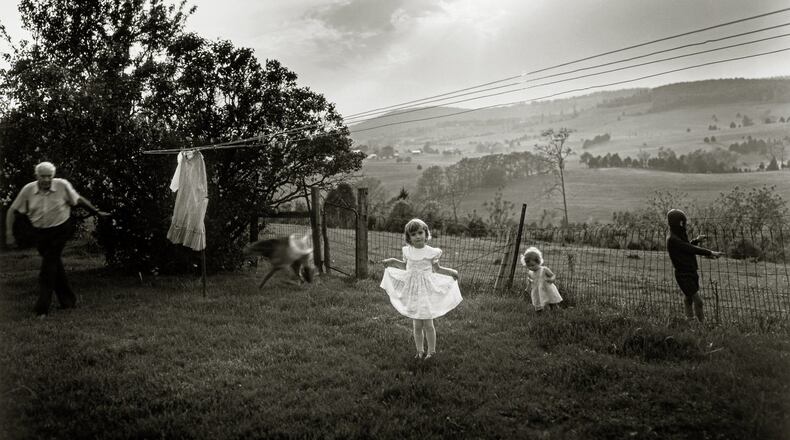Some Southern women might own batter-stained Junior League cookbooks. But Sally Mann’s recipe book is “The Wet Plate Process: A Working Guide.” Showcased in a glass vitrine and turned to a page featuring a formula for silver gelatin solution, the pages are marked by crime scene splatters of chemicals.
In “Sally Mann: A Thousand Crossings” that well-worn book is evidence of Mann’s own technical experimentation and desire to master some of photography’s antiquated, mercurial and beautiful forms from tintypes to ambrotypes.
An exhibition devoted to one of photography’s most enduring contemporary voices, “A Thousand Crossings,” which originated as a collaboration between the National Gallery of Art and the Peabody Essex Museum (former home of the show’s co-curator and the High’s new curator of photography Sarah Kennel) offers a complicated and very human portrait of Sally Mann.
Over a more than 40-year career Mann has continually tackled the intertwined nature of love and death in images of her family. But Mann in “A Thousand Crossings” also examines the peculiar circumstance of her home in Lexington, Virginia, a place haunted by the ugliness of slavery and racism. Where Mann’s work once proudly reveled in the singularity, complexity and romance of the South, now she grapples with it fully in an effort to understand what the South represents for black Americans, often through the touchstone of her beloved African American nanny Virginia “Gee Gee” Carter who is referenced in word and image throughout the show.
»»ALSO AT THE HIGH: Read our review of "Strange Light:
Like so many well-intentioned white people grappling with racism, Mann can be both fiercely earnest and prone to awkwardness. But the beauty of Mann’s vision as an artist is that she continues to grow and tackle new challenges.
Unlike Ansel Adams’ heroic, majestic West, Sally Mann’s South is often a scary, fraught, uncanny place. It is at once the cradle that nurtured her children in an idyllic Eden of velvety rivers and fields, but also the pitiless soil worked for hundreds of years by captive people, and the haunted battlefields of Antietam where the blood of 23,000 dead soldiers seeped into the land.
It’s hard to think of a photograph more loaded than “Deep South, Untitled (Scarred Tree)” (1998) of an ugly gash in a tree that reads like the scar tissue residue of the South’s brutal violence. Her inky, frightening tintypes of swamps are a nightmare vision of how the South looked to fugitive slaves, a night vision-evocative upside down world that recalls Dawoud Bey’s similarly haunted images.
There are fascinating revelations in this exhibition including the tightrope between masterminding special effects in her photography — like her purposeful splatters of dust to evoke beauty amidst horror in “Battlefields, Antietam (Starry Night)” (2001) — and serendipity. A romantic technician, Mann balances accident, or what she calls “the angel of uncertainty,” and careful stagecraft. She tiger mothers an image like “Easter Dress” (1986) of her daughter Jessie carefully orchestrated and posed. Then, on the flip side, she embraces spontaneity with a hand-held camera that immediately captures the macabre drama of Kool-Aid colored blood streaking her son Emmett’s chest in “Bloody Nose” (1991). One imagines Mann grabbing her camera instead of a tissue to stem the blood flow. It’s, frankly, exhilarating to see this hidden, layered vision of motherhood combining Mann’s single-mindedness and devotion to her art along with her fierce love of her children as commingled forces.
Mann’s images are beleaguered by death at every turn: Civil War battlefields, the fear of death in every parent’s heart, the soul death of slavery for an America that won’t acknowledge it. There are countless talented female photographers in the history of the medium, but it’s hard to think of one with such unique gifts in documenting both the micro arc of her own experience and the macro tapestry of American life or the obsessions of photo history: beauty (here, just as often male beauty) and landscape. All are considered and shaped through a female point of view and art history is all the better for that vantage.
Through February 2. 10 a.m.-5 p.m. Tuesdays-Thursdays and Saturdays; 10 a.m.-9 p.m. Fridays; noon-5 p.m. Sundays. $14.50, ages 6 and above; free, children 5 and younger and members. High Museum of Art, 1280 Peachtree St., N.E., Atlanta 404.733.4444, www.high.org
Bottom line: Sally Mann’s ongoing fascination with family, death and the Southern landscape deepens with a consideration of how race defines place in this captivating retrospective.
About the Author
Keep Reading
The Latest
Featured






